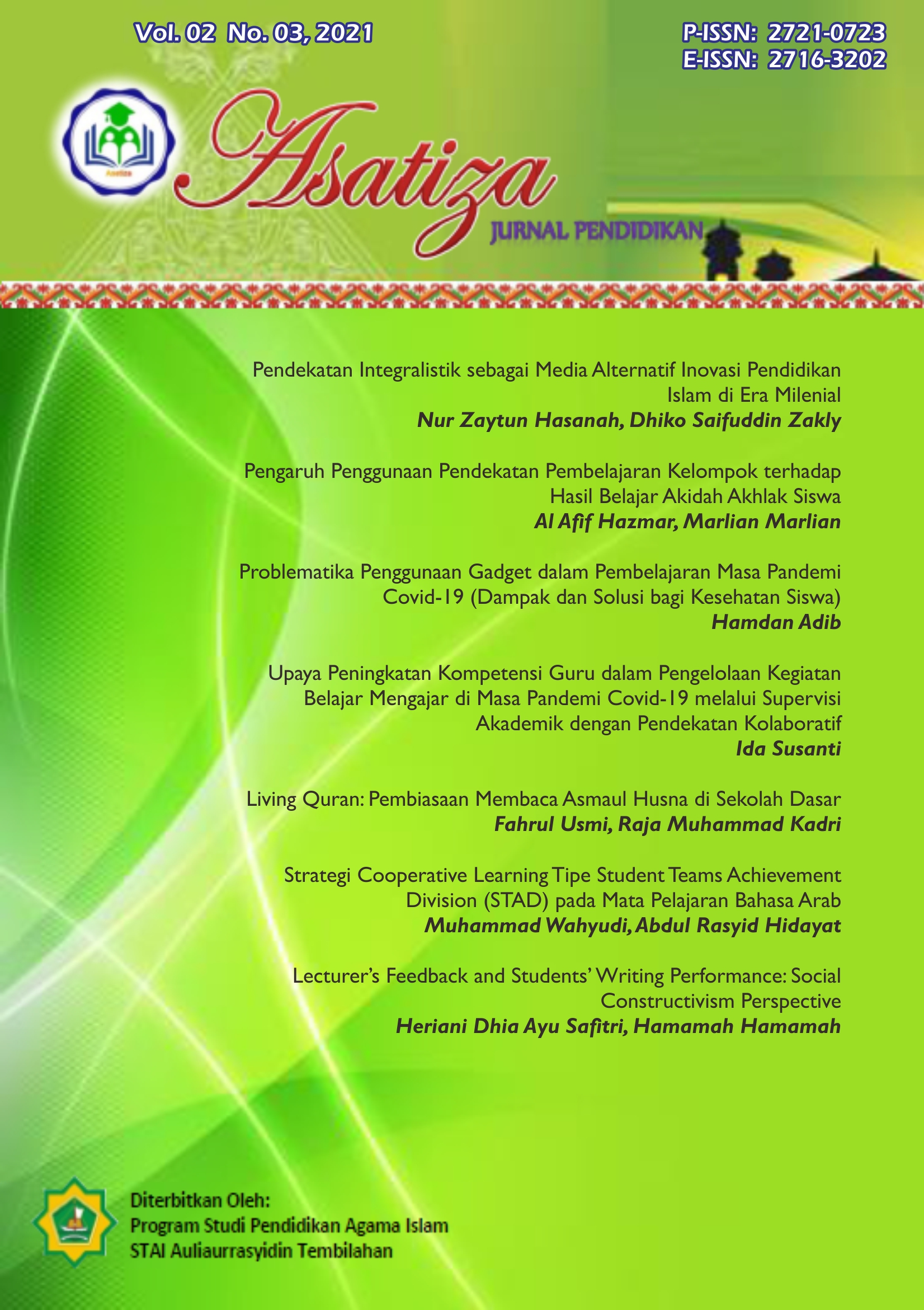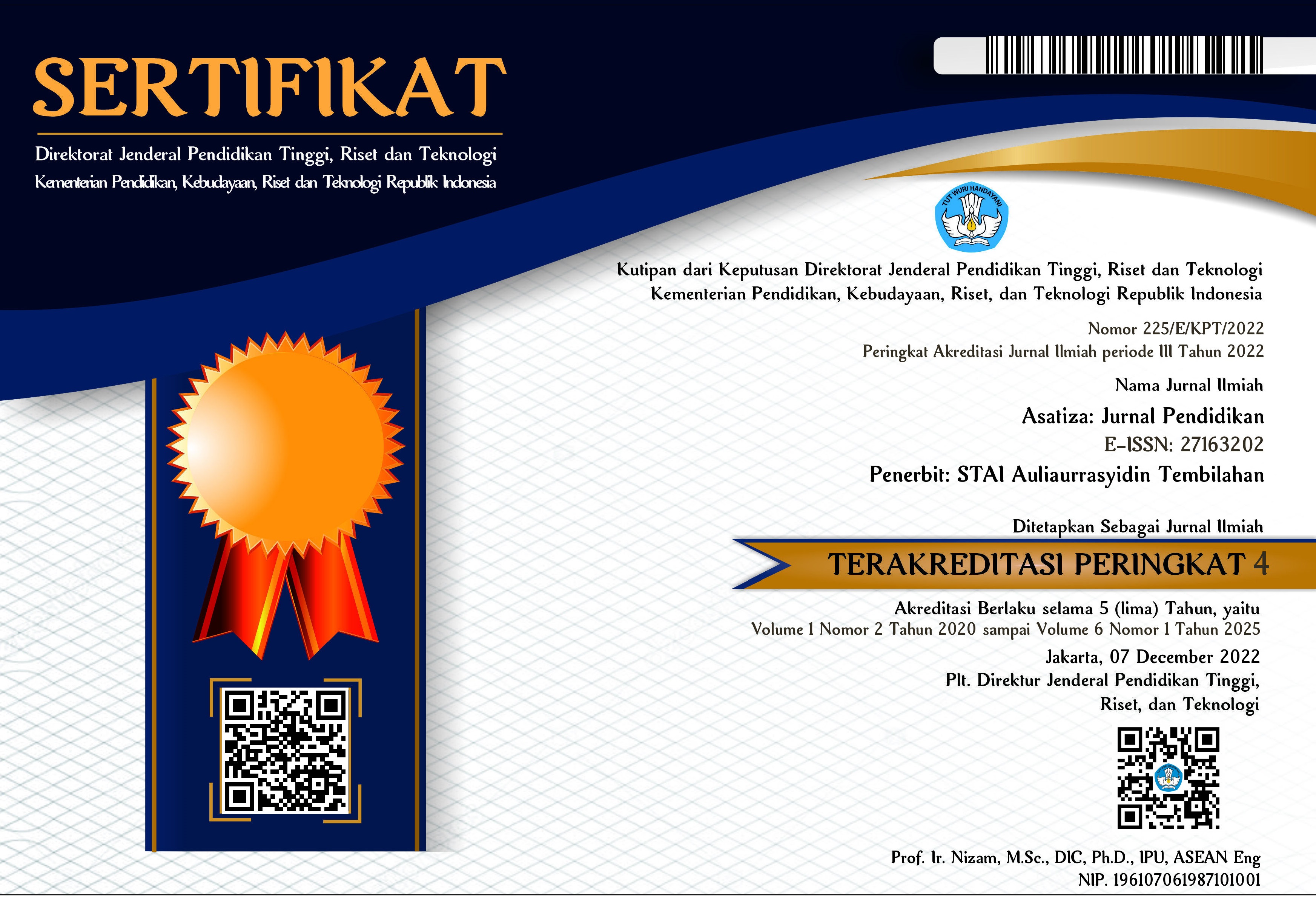Upaya Peningkatan Kompetensi Guru dalam Pengelolaan Kegiatan Belajar Mengajar di Masa Pandemi Covid-19 melalui Supervisi Akademik dengan Pendekatan Kolaboratif
DOI:
https://doi.org/10.46963/asatiza.v2i3.400Keywords:
Supervision, Collaborative, Teacher, Covid-19Abstract
Collaborative supervision is partnership-based supervision between the supervisor and the supervisee. The purpose of this research was to find out whether academic supervision through a collaborative approach can improve teacher competence in managing teaching and learning activities and how teachers' responses to the learning in the Even Semester 2020/2021 at SMA Negeri 2 Bunguran Timur. This research method was classroom action research with two cycles. The results showed that academic supervision through a collaborative approach could scientifically improve teachers' competencies in the Management of Teaching and Learning Activities, as evidenced by the increase of supervision percentage from the aspect of academic supervision that met all of the criteria from 31% to 83% after the action. The teachers responded positively to the academic supervision using a collaborative approach, which can help them in teaching and learning activities.
Downloads
References
Ausykarni. (2019). Peningkatan kemampuan guru dalam pengelolaan pbm melalui pelaksanaan supervisi akademik dengan pendekatan kolaboratif di SMPN I Ujung Batu semester 1 tahun pelajaran 2016/2017. Jurnal Edu Research, 8 (1), 11-21. https://doi.org/10.30606/jer.v8i1.802
Departemen Pendidikan Nasional. (2006). Standar Kompetensi PTK-PNF dan Sistem Penilaian. Jakarta: Direktorat Pendidik dan Tenaga Kependidikan Pendidikan Nonformal, DirektoratJenderal Peningkatan Mutu Pendidik dan Tenaga Kependidikan.
Departemen Pendidikan Nasional. (2005). Undang-undang No.14 tahun 2005 tentang Guru Dan Dosen
Flanders, N. A. (1976). Interaction analysis and clinical supervision. Journal of Research & Development in Education, 9(2), 47–57.
Lerch, R. D. (1980). The clinical model: The optimum approach to supervision. The Clearing House, 53(5), 238-240.
Majid, A. (2005). Perencanaan Pembelajaran: Mengembangkan Standar Kompetensi Guru. Bandung, Bandung: PT Remaja Rosdakarya.
Mulyasa, E. (2003). Kurikulum Berbasis Kompetensi: Konsep, Karakteristik, dan Implementasi. Bandung: PT Remaja Rosdakarya.
Reavis, C. A. (1977). A test of the clinical supervision model. The Journal of Educational Research, 70(6), 311–315. http://www.jstor.org/stable/27537041
Robbins, S. P., (2001). Organizational Behavior. New Jersey: Pearson Education International
Robotham, D. (1996). Competences: Measuring the Immeasurable. Management Development Review, 9(5), 25-29.
Spencer, L. M., J. & Signe M., Spencer. (1993). Competence at Work: Models for Superior Performance. John Wiley & Sons. Inc.
Sofo. F, (1999). Human Resource Development, Perspective, Roles and Practice Choice. Business and Professional Publishing, Warriewood, NWS
Thompson III, J. C. (1979). On Models of Supervision in General and on Peer-Clinical Supervision in Particular. Association for Supervision and Curriculum Development: Washington
Usman, M. U. (1994). Menjadi Guru Profesional. Bandung: PT Remaja Rosdakarya.
Wibawa, B. (2003). Penelitian Tindakan Kelas. Jakarta: Departemen Pendidikan Nasional Direktorat Jendral Pendidikan Dasar dan Menengah Direktorat Tenega Kependidikan
Wartini, W. (2018) Upaya peningkatan kompetensi guru dalam melaksanakan proses belajar mengajar melalui supervisi akademik di SDN 011 Bukit Raya Singingi Hilir Kecamatan Singingi Hilir. Jurnal Pajar (Pendidikan dan Pengajaran), 2(6), 1023-1030. http://dx.doi.org/10.33578/pjr.v2i6.6546
Downloads
Published
Issue
Section
License
Authors who publish with this journal agree to the following terms:
1. Copyright on any article is retained by the author(s).
2. The author grants the journal, right of first publication with the work simultaneously licensed under a Creative Commons Attribution shareAlike 4.0 International License that allows others to share the work with an acknowledgment of the work’s authorship and initial publication in this journal.
3. Authors are able to enter into separate, additional contractual arrangements for the non-exclusive distribution of the journal’s published version of the work (e.g., post it to an institutional repository or publish it in a book), with an acknowledgment of its initial publication in this journal.
4. Authors are permitted and encouraged to post their work online (e.g., in institutional repositories or on their website) prior to and during the submission process, as it can lead to productive exchanges, as well as earlier and greater citation of published work.
5. The article and any associated published material is distributed under the Creative Commons Attribution-ShareAlike 4.0 International License











2.png)



